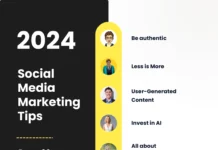
Digital marketing and advertising have become increasingly fragmented, with new tools and platforms emerging all the time. Keeping up with all these changes can be overwhelming. But, as marketers begin to see a return on investment from creating branded social media content, they demand more and more solutions to the problems they encounter on a daily basis.
If you are looking for some of the best digital marketing tools available to assist in your online campaign, this article will help you answer that question. Read on to discover more about these helpful tools for digital marketing, including information on how they can be used most effectively and examples of brands that use them.
Email Marketing Tools
Design Tools for Marketers
Video Editing and Creation Tools for Marketers
Communication and Collaboration Tools
Digital Marketing Tools
Email Marketing Tools
An email marketing tool is a software application that helps businesses manage their email marketing campaigns. It can be used to create and send newsletters, promotional emails, and targeted campaigns. Email marketing tools can also help digital marketers to track the results of their campaigns, including open and click-through rates. Email marketing tools typically include features such as contact lists, email templates, email scheduling, email tracking, and reporting.
There are a number of popular email marketing tools available on the market today. Some of the most popular include MailChimp, AWeber, Constant Contact, and GetResponse. Each of these tools offers a different set of features and benefits, so it’s important to choose the one that best meets your needs.
1. Mailchimp
There are many reasons why Mailchimp is one of the best options for email marketing. For one, it’s affordable. It’s among the cheapest on the market. And even better, it has a very generous freemium plan. You can send up to 10,000 emails per month for free to up to 2,000 contacts. Imagine what you could do with that. You could kickstart a new business or just validate the idea before you invest any more money in it. And if you need more, it’s only $10/month for up to 50,000 emails. Prices for similar tools usually range from $8 to $20, so it is clearly among the cheapest. Another important feature is the fact that it is easy to use. Even if you’re not a tech-savvy digital marketer, you’ll be able to compose astonishing emails with their drag-and-drop email builder. Plus, there are tons of templates and resources available to help you get started. And if you do need help, their customer support is amazing. They have live chat, phone, and email support available 24/7. But unfortunately, this extensive support is not available in the free plan.
2. Sendinblue
Sendinblue is a powerful and versatile email marketing platform that offers a wide range of features and options to help businesses of all sizes grow and improve their customer relationships. One of the things that makes Sendinblue special for digital marketers is its focus on delivering high-quality, personalized customer experiences. With Sendinblue, businesses can create highly targeted email campaigns based on customer behavior and preferences and then use their advanced reporting and analytics tools to track the results and optimize their campaigns for even better results. Additionally, Sendinblue offers a wide range of integrations with other popular business applications and services, making it easy to add Sendinblue’s powerful email marketing capabilities to any existing workflows and systems. Some of the disadvantages are the fact that it might not be the easiest to use, at least if we compare it to Mailchimp. Also, the email builder could be better. And the price is bigger if we compare it to Mailchimp: 40,000 emails for $25. However, if the other targeting features and reporting are a must for you, then it might be a better choice even if the price is higher.
3. Convertkit
Convertkit is best for online marketers and bloggers who want to build a loyal following and grow their business. It offers a wide range of features that allow digital marketers to create highly customized email campaigns and track their results. Some of the key features that make ConvertKit different from the rest include its easy-to-use interface, powerful automation capabilities, and its excellent customer support, which can be extremely helpful when you’re first getting started with building your email list. This holds up when we compare it to Mailchimp. However, it has some disadvantages. Small businesses with a limited subscriber list can benefit from ConvertKit’s reasonable pricing, but most medium-sized businesses cannot. Pricing becomes more costly as you gather more followers, so if you have fewer than a thousand contacts, you will begin with a $29 monthly subscription. If you have more than 50,000 subscribers, you will be charged a lot of money. Therefore, if you anticipate growing a lot, you may be better off with one of the other options like Mailchimp or even Sendinblue. It does not scale well with lower-quality subscribers in large numbers. It’s relevant for a more specific and high-value audience.
Design Tools for Marketers
There are many design tools available for marketers today, ranging from simple online tools to more complex software programs. These tools allow marketers to create professional-looking marketing materials such as brochures, flyers, and newsletters. Additionally, they can also be used to create website designs, logos, and other branding elements. Some of the most popular design tools used by marketers include:
1. Canva
Canva is a popular online design tool that’s beloved by many digital marketers for its simple and user-friendly interface. With Canva, you can easily create professional-looking designs for your marketing materials, even if you don’t have any prior design experience. Canva is a special kind of online design platform that enables anyone, regardless of design experience, to create high-quality visuals for their businesses or personal projects. Canva offers a wide range of templates for users to choose from, as well as a simple drag-and-drop interface that makes creating designs quick and easy. Plus, with Canva’s library of over 1 million stock images, illustrations, and icons, users can find the perfect visual to complement their message. But, besides all these good things, there are some bad ones as well. There seems to be a lot of upselling and marketing within the app, which can be annoying. And some people seem to hate the interface, while another group of people considers the templates to be limiting and not very flexible. So, make sure you check all these before you commit to it for the long run.
2. Adobe Photoshop
Adobe Photoshop is a widely used design program that offers a vast array of features and capabilities. While it can be somewhat challenging to learn at first, Photoshop is a powerful tool that can help you create stunning visuals for your marketing campaigns. I have been using Photoshop for about 10 years now. I originally started using it for basic photo editing, but I have since then learned how to use it for graphic design and web design. However, there are some limitations to using photoshop for web design. For example, Photoshop is not well suited for creating responsive designs. Additionally, Photoshop is not a good tool for coding HTML and CSS. And over time, better and better alternatives were released for such types of endeavors. However, Photoshop remained among the best tools for photo editing, and I think it will stay there for a lot longer.
3. GIMP
GIMP is another free image editing program that can be used to create graphics and visuals for marketing purposes. While it doesn’t have as many features as Photoshop, it’s still a powerful tool that can be used to create high-quality visuals for digital marketing campaigns. The thing that differentiates GIMP the most from the rest of the photo editing software is the fact that it is free. And even better, in spite of the fact that it is free, it is constantly being updated with new features and improvements, which makes it an essential tool for anyone who wants to stay ahead of the curve in the world of graphic design. Whether you’re a professional graphic designer or just someone who likes to play around with photos, GIMP can be a valuable asset.
Video Editing and Creation Tools for Marketers
There are a few different tools used to create videos for digital marketing. One popular option is to use a video editing program like Adobe Premiere Pro, Apple Final Cut Pro, or Sony Vegas. With them, you can create professional-looking videos by adding your own footage, music, and effects. Another option is to use an online video creation service like Animoto or Biteable. These services make it easy to create videos by providing you with templates, stock footage, and other tools. All you need to do is add your own content and customize the video to your liking. Here are some of the most popular tools and platforms for video creation, animation, and editing:
1. Vimeo
Vimeo is a popular video-sharing website that is useful for digital marketing. It allows users to upload, share, and view videos. Vimeo is different from YouTube in a few key ways: first, it has a more refined and artsy user base, and as such, the videos on Vimeo tend to be of higher quality than those on YouTube. Second, Vimeo has a stronger focus on privacy and security, allowing users to choose who can see their videos and who can’t. Finally, Vimeo doesn’t have any ads, meaning that users can enjoy videos without having to sit through commercials. Vimeo also has a more tight-knit community feel than YouTube and is popular with independent filmmakers and creative professionals. In addition, Vimeo also offers paid subscriptions that allow users to access even more features, such as unlimited HD video uploads and no limits on video duration. If we compare it to YouTube, it has some disadvantages as well. For example, YouTube has a much larger user base, which means there are more people uploading and watching videos on the site. This also means that there is a greater variety of content available on YouTube. Additionally, YouTube is owned by Google, which gives it a major advantage in terms of searchability and overall visibility. Finally, YouTube offers a number of features and benefits that Vimeo does not, such as the ability to monetize videos and use annotations and links.
2. Biteable
Biteable is a video creation platform that enables users to create professional-looking videos without any prior video editing experience. Biteable is different from other video creation platforms in several ways. First, Biteable offers a wide range of professionally-designed video templates that can be customized to fit any brand or message. Second, Biteable’s video editor is extremely user-friendly and easy to use, even for those with no prior video editing experience. Finally, Biteable provides users with access to a library of high-quality stock footage and photos, so they can create videos that look truly professional. One of the things that made Biteable a good fit, especially for beginners, is the money-back guarantee option if users are not satisfied with their videos. This means that anybody can jump on their platform to try to create a good video for their small business or even side hustle. And you don’t have to communicate everything you want to another person. You just do it yourself, from beginning to end, in the particular way you think will be cool. And you don’t have to pay anything if you don’t like the result.
3. Animoto
Animoto is a video creation platform that allows users to create professional-looking videos from their photos and video clips. It offers a wide range of features and templates to choose from, making it an excellent option for digital marketers who are looking to create videos to promote their business. One of the most important things that set Animoto apart from the rest is the access to a very big library of stock videos and photos. They have so many photos and videos because they partnered with Getty Images. If we compare it to Biteable, their library is bigger, which means that you have more options to choose from when making your videos. But the digital marketing tool has some disadvantages as well when compared to Biteable. Animoto has pre-built video sequences called storyboards, which are similar to Biteable’s templates, which you can customize with your own text and images. These storyboards are very important for marketers because you can choose a favorite template and easily create a video very fast, just by adding content to it. And the bad news is that Animoto’s offer is more limited. There are more limitations in terms of fonts, I suggest you check them out before you commit to it for the long run. But if these small drawbacks are not something essential for you, Animoto is a very good choice, especially for access to a large stock video and photo collection.
Communication and Collaboration Tools
In this day and age, you can’t really have a successful project without using collaboration and communication tools. From Google suite to good old-fashioned email, from project management software with strong collaboration features to communication apps like Slack, the matrix is replete with digital solutions. Since there are so many options out there, I picked a digital marketing tool for you to explore:
Chanty
As a digital marketing tool, Chanty is one of the best software programs for collaboration and communication. It is less formal than an email and doesn’t consume much of your time as you reach your goals faster. It allows marketing teams to be more economical with their tasks without sacrificing the quality of communication. The benefits and features include keeping all your communication under a single roof, automating your marketing workflows, improving client satisfaction and retention, using the built-in task manager, and managing workflows dynamically using the Kanban board.
Conclusion:
Digital marketing tools are essential for businesses of all sizes. They provide a way to reach and engage potential and current customers and to measure and analyze marketing performance. These tools can help you save time and money by automating many of the tasks involved in marketing. They can help you stay ahead of the competition by giving you the ability to quickly adapt to changes in the market.
See also: Project Management Tools for Social Media Managers











